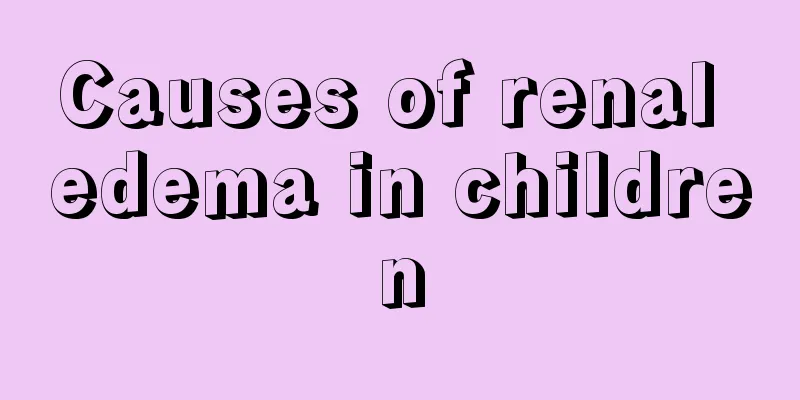Causes of renal edema in children

|
Many children are prone to kidney disease during childhood, and the chance of kidney disease is also very high. I believe many people have heard of pediatric nephritis, pediatric nephrotic syndrome, pediatric kidney disease, etc. These diseases bring great harm to children's bodies. Many children also suffer from edema due to kidney disease. This is called renal edema. Edema starts from the face and slowly appears in the limbs. So what are the causes of renal edema in children? Renal edema usually occurs in areas with loose tissue, such as the face, eyes, and feet. These areas are prone to edema. If the edema is severe in some patients, the whole body will also be swollen. The skin will concave when pressing the edematous area with your fingers. At this time, you need to see a doctor in time for further treatment. You can choose Chinese medicine for long-term treatment. You should pay attention to daily exercise, avoid touching cold water, have a comprehensive and balanced diet, and drink enough water every day. 1. Decreased glomerular filtration rate: For example, in acute glomerulonephritis, inflammatory exudates and endothelial cell swelling cause the glomerular capillary lumen to narrow or occlude, resulting in reduced glomerular blood flow and reduced filtration. Chronic glomerulonephritis causes a large amount of glomerular fibrosis and loss of function, which reduces the glomerular filtration area and affects the filtration rate. This is the main mechanism of renal edema. 2. Glomerular-tubular imbalance: In kidney disease, the glomerular filtration rate decreases, while the renal tubular damage is relatively mild and can maintain more water and sodium reabsorption. For example, in nephrotic syndrome, the kidney itself has difficulty in excreting water and sodium, resulting in glomerular and tubular imbalance and redistribution of renal blood flow. Renal nerve activity is enhanced and the production of natriuretic hormone is inhibited, which increases the reabsorption of sodium and water by the renal tubules and causes furniture edema. 3. Allergic toxins: The immune damage during glomerulonephritis activates complement to produce allergic toxins, which increases the permeability of capillaries throughout the body, causing a large amount of water and plasma proteins to penetrate into the tissue gap and produce edema. 4. Secondary aldosterone increase: When kidney disease occurs, renal blood flow decreases and renin secretion increases, leading to increased secondary aldosterone secretion, which increases the reabsorption of sodium in the distal renal tubules and produces edema. 5. Decreased plasma colloid osmotic pressure: In nephrotic syndrome, due to a large amount of proteinuria, plasma protein, especially albumin, is lost excessively, and the plasma colloid osmotic pressure is reduced. When albumin is lower than 25g/L, it can cause systemic edema and even abdominal (pleural) effusion. 6. Heart failure: If kidney disease is accompanied by hypertension, anemia, and electrolyte imbalance, it may cause heart failure, which may aggravate edema. The above are various causes of renal edema in children. If a child suffers from various symptoms caused by kidney disease, then it is necessary to check whether the child is caused by the above reasons. There are many types of kidney disease, and the child’s kidney disease must be treated in time. If it is nephritis, then the child needs to be given dialysis treatment in time. During the treatment, the child should not have any psychological burden, which will greatly affect the treatment of the child’s disease. |
<<: Treatment of heart failure in children
>>: What to do if children have severe anemia
Recommend
What is the treatment for children's upper respiratory tract infection and cough?
Children are prone to upper respiratory tract inf...
What is the probability of retinopathy of prematurity?
For families who have just given birth to a prema...
What should I do if my baby has a runny nose?
It is a common phenomenon for babies to have a ru...
Can children eat tiger tail wheel?
The tiger wheel is a plant that is now also used ...
What causes nosebleed in children?
We must pay a lot of attention to the issue of wh...
Treatment of nephrotic syndrome in children
Nephrotic syndrome is a disease that has a great ...
What to do if children's hair turns yellow
The problem of children's yellowing hair is a...
What fruits are better for children with bronchitis?
Once a child's bronchitis attacks, it is ofte...
Why do babies always lick their lips?
In life, many babies like to lick their lips. Man...
What are the benefits of eating pig liver for infants and young children
I believe everyone knows that pork liver contains...
Six-month-old baby has phlegm sound when breathing
Under normal circumstances, the breathing sound o...
How to guide children during their rebellious period
We all know that children have a rebellious perio...
Causes and treatments of pus in children's ears
There are many things that can happen to the ears...
What's wrong with a child having a low fever and sweating?
Low-grade fever is a relatively common disease at...
Prevention of febrile seizures in children
The phenomenon of high fever convulsions in child...









